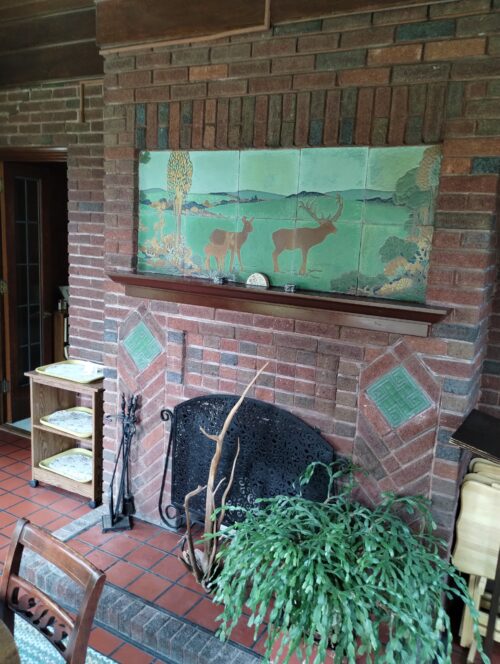Hidden Hunters Park mansion up for sale

Duluth grain magnate W.J. McCabe and his wife Jane Chidlaw McCabe built this Georgian-style colonial mansion in 1914. It is located in Hunters Park, about two miles uphill from Glensheen Mansion. (Photos by Mark Nicklawske)
Duluth is famous for its turn-of-the-century mansions proudly showcased in busy, well-touristed east-side neighborhoods, but a few historic homes are tucked away in unexpected places far from the grand Lake Superior shoreline.
One of those hidden gems is up for sale.
The McCabe Renewal Center, located at 2125 Abbotsford Ave., has been placed on the market for $1.3 million by the Benedictine Sisters of the St. Scholastica Monastery. The three-story, nine-bedroom home was built by grain magnate W.J. McCabe and his wife Jane Chidlaw McCabe in 1914. It has operated as a retreat since 1977.
The 6,400-square-foot red brick house sits on 3.5-acres of well-manicured lawn and gardens in Hunter’s Park, a comfortable, middle-class neighborhood two miles uphill from the most visited historic home in the state — Glensheen Mansion.
Re/Max real estate agent Ben Funke, who is selling the property for the Benedictine Sisters, said the unusual location and beautiful grounds set the property apart from other mansions located on busy Duluth streets or in denser city neighborhoods.
Funke said a buyer won’t have any “keeping-up-with-the-Jones” pressure as there are few comparable properties in the neighborhood. “Not that it happens in Congdon, but it can,” he said. “I do feel like when I help people buy, there are some people that want to be more under the radar — that’s what this place is.”
“Of course, anytime you buy a mansion there are going to be people who will be like: ‘Who just bought that?’”
The McCabe mansion was designed by Duluth architect Arthur Hanford as a Georgia-style colonial. Bob Berg of the Duluth Preservation Alliance said it resembles the Ordean house at 2307 E. Superior St. and the Merriweather Inn at 2316 E. First St., both built during the same era. The sprawling lawn and gardens are similar to the Millen mansion on Vermillion Road near Mount Royal and the Cavour Hartley House located below Northland Country Club on Superior Street.
But few if any other Duluth mansions feature both the stately colonial look and secluded, expansive green space. Even Glensheen has always had a busy London Road or railroad track clamoring behind it.
“It’s a little bit more like a country estate,” said Berg. “With that much land around it, instead of being on a city lot — or a few city lots.”

The Benedictine Sisters of the St. Scholastica Monastery have operated a retreat at the mansion since 1977. They hosted their final event in the space this spring.
The large green space makes for a spectacular drive-up. A front door is surrounded by a knee-high brick wall and encased in glass and pillars. The road curves behind the house for a tree-lined rear entrance and access to a nearby brick barn that has been remodeled into a four-bedroom living space.
Inside, the house is remarkably well-preserved. It features all of its original fixtures, luxurious wood trim, many floor-to-ceiling windows, a grand staircase, a library room and five wonderful vintage bathrooms. A basement recreation room is anchored by a fireplace that is said to have been made out of stones from all of the lower 48 states, said Funke.
A home tour highlight is a beautiful sunroom centered around a brick fireplace and its built-in tile wildlife scene. The room pops with a red tile floor and curved windows.
“They don’t make homes like they used to,” said Funke. “With the Benedictine Sisters being the owner of this place — the ones that are in charge of the home and in charge of its finance — their fear was … that someone would come here and level this. You don’t level this kind of house. It’s too expensive to duplicate.”
Funke said potential buyers have inquired about establishing the home as a short-term rental property but the use does not fit city zoning. The large acreage could also be a target for subdivision and new home construction.
Berg said he hopes whoever buys the property will work to preserve it.
“When you live in an old house, it’s my philosophy that you are not really the owner — you’re a caretaker,” he said. “Hopefully you leave it in good shape and you don’t destroy anything.”
The house has undergone at least one significant change since the McCabe family donated the property to the Benedictine Sisters in 1940. During a stint as a retirement home, the original kitchen was converted to two bedrooms and a new, larger kitchen was installed in the basement.

A new kitchen was built in the basement of the McCabe mansion. The original kitchen was removed and turned into bedrooms when the house became a retirement home in the 1940s.
The house has been used as a retreat for church officials and nonprofit groups for more than four decades. Wall-to-wall carpeting and neutral paint colors give it an institutional feel in places but this could be easily corrected by a good interior designer.
Funke said the home needs someone who can make its historic beauty shine. “It’s just a phenomenal property,” he said.
In a message posted online May 24, Sister Beverly Raway, prioress of the St. Scholastica Monastery, said the decision to sell the McCabe Renewal Center was difficult.
“We recognize the invaluable role the McCabe Renewal Center has played in nurturing souls and fostering contemplation over the years,” she said. “Its legacy –- and all those who have participated in it through the years -– will forever be cherished in our hearts.”
Raway said the McCabe property closure and sale creates an opportunity to utilize the Center for Spirituality and Enrichment — located on the St. Scholastica Monastery grounds in Kenwood. Like the McCabe property, the center offers programs and retreats, overnight accommodations, meeting rooms and beautiful gardens.
The Benedictine Sisters have been active in Duluth since 1892. The group established St. Mary’s Hospital in 1898 and purchased 160 acres of foreclosed farmland along Kenwood Avenue between 1899 and 1907. The site is the current home to the College of St. Scholastica and the St. Scholastica Monastery.
“As we bid farewell to one chapter, we eagerly anticipate the unfolding of the next,” she said. “We embrace this transition with open hearts and unwavering faith, knowing that the spirit of renewal resides not in a building, but in the boundless love that connects us all.”
Recommended Links:
Leave a Comment
Only registered members can post a comment , Login / Register Here
















No Comments